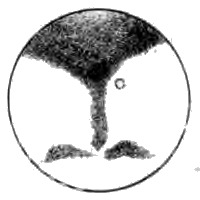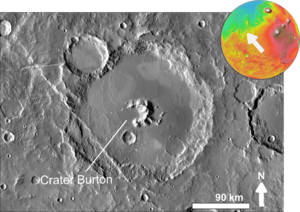Charles E. Burton facts for kids
Charles Edward Burton (born September 16, 1846 – died July 9, 1882) was an amazing astronomer from Ireland. He made important discoveries about planets like Mars.
Early Life of a Stargazer
Charles Edward Burton was born in Barnton, England. His parents were Irish. His father, Reverend Edward W. Burton, was a church minister there. Charles was often sick, so he was taught at home. By the time he was 15, he loved astronomy very much. He even tried taking photos of the sky and stars. Later, his family moved back to Ireland. They settled in Loughlinstown, County Dublin.
Charles Burton's Astronomy Career
In February 1868, Charles joined the observatory of Lord Rosse. He worked as an assistant astronomer. He learned to grind huge mirrors for telescopes. Some of these mirrors were 15 inches (38 cm) wide! Lord Rosse's father had built the world's largest telescope. It was a 72-inch (183 cm) reflector telescope. People said the mirrors Charles ground were the best. Later that year, Charles earned a degree from Trinity College Dublin.
In March 1869, Charles left his job because he was still not well. The next year, he went on a trip to Sicily. He went there to watch a total solar eclipse on December 22. He later shared what he saw with the Royal Irish Academy. Between 1870 and 1874, he studied the shadow of Jupiter's moon, Ganymede. He noticed the shadows looked longer than expected.
In 1874, Charles went on another big trip. He was a photographer for a British expedition. They went to the island of Rodrigues in the Indian Ocean. Their goal was to watch the transit of Venus. This is when Venus passes in front of the Sun. He used a 12-inch (30 cm) telescope he built himself. With it, he observed nebulae that could only be seen from the southern part of Earth.
After this, he spent almost a year at the Greenwich Observatory. He measured photos taken during the transit. Then he worked for two years at Dunsink Observatory near Dublin. He had to retire again in August 1878 due to his health. His observations of Venus suggested that the fuzzy edges seen in photos were proof of a planet's atmosphere.
Charles continued his work from his father's house in Loughlinstown. He built his own observatory there. It had 8-inch (20 cm) and 12-inch telescopes. In 1879, Mars was closest to Earth. Charles confirmed what another astronomer, Giovanni Schiaparelli, had seen. Schiaparelli had drawn 'canals' on Mars. Charles drew different ones. The word 'canals' was a mistranslation. It should have meant 'channels'.
His drawings of these channels were even put on a map of Mars. But Charles warned that astronomers should be careful. He said we shouldn't be too sure about these features. He wrote that it's hard to see them clearly. He also said we don't know much about Mars yet. In the 1960s, the NASA Mariner 4 probe finally showed that these straight lines don't exist.
Charles Burton also found the first scientific proof of clouds on Mars. He wrote notes about this on January 5, 1880. He thought they were ground mists. He also thought they were caused by the Sun's energy on the ice at the south pole. A Greek astronomer, E. M. Antoniadi, later called this observation "genius."
Charles was preparing for another trip to watch the transit of Venus in 1882. This time, the trip was to Durban, South Africa. But his heart disease got worse. He had a fatal heart attack in a church in Castleknock on July 9, 1882. He was only 35 years old. Some people thought his early death was due to being out in the cold nights too often.
Charles Burton's Legacy
His friends and colleagues were very sad to lose such a brilliant astronomer so young. His friend, Wentworth Erck, wrote about him. He said Charles was a good person. He was also a very skilled scientist and an amazing observer of the stars.
In 1973, Charles Burton's work was honored. The International Astronomical Union named a crater on Mars after him. It is called the Burton crater.



